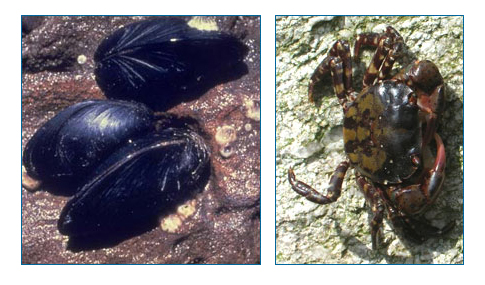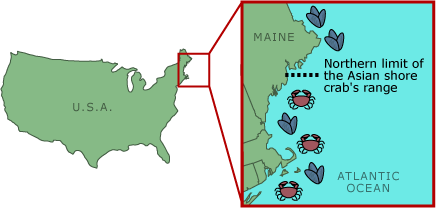
Evolution is a slow process through which species gradually adapt to their environments, right? Well perhaps sometimes, but not for the blue mussel. In August of 2006, Aaren Freeman and James Byers of the University of New Hampshire announced that the blue mussel has evolved defenses against a new invasive predator in just 15 years! Compared to the million-year time scale of the fossil record, that’s the blink of an eye.
The Asian shore crab invaded the eastern coast of the U.S. about 15 years ago and began foraging on the native blue mussel, which, at the time, had no defenses against the exotic, aggressive crab. But these days, the blue mussel responds to the crab’s presence by building up a thicker shell over the course of a few months. That extra buttressing helps thwart the crab’s attacks — and makes the mussel a harder nut to crack!
Where's the evolution?
The news articles on this mussel/crab interaction describe it as an example of evolution in action — but how do we know that it’s evolution at work? Sure, the mussels respond to the new predator by developing thicker shells — but many organisms respond to new situations in sensible ways, without any evolution at all. After all, the blue mussel also responds to the waterborne chemical cues of more familiar predators (such as the green crab) by developing a thick shell. Perhaps the shell-thickening response is just an old tool that happens to be useful in a new situation — and any crab (native or invasive) will trigger the mussel to beef up its armor. So how do we know that the mussel has actually evolved in response to the Asian shore crab?
To show that the mussel has evolved, Freeman and Byers needed evidence that the mussel’s response had changed over time — but unfortunately, no one was measuring the blue mussel’s predator response 15 years ago, before the arrival of the Asian shore crab. Freeman and Byers, however, were able to take advantage of a quirk in the ranges of these two animals: the blue mussel lives up and down the coast of New England (including all of Maine), but the Asian shore crab has not yet ventured into Northern Maine. That means that Northern Maine mussels have never been exposed to the Asian shore crab — and have not experienced any natural selection that might cause them to respond to this predator in particular. Those northern mussels, then, serve as an indication of what all blue mussels were probably like 15 years ago, before the invasion.

Based on this reasoning, the researchers hypothesized that the southern mussel populations had evolved in response to the Asian shore crabs but that the northern mussels had not. To test this hypothesis, they needed to compare the predator defense responses of northern and southern mussels. They set up an experiment in which they housed mussels from different parts of New England in buckets. Then, they placed different crabs in small cages inside the buckets — so that the crabs could not kill the mussels but so that the mussels could pick up on any chemical cues released by the crabs into the water.
After three months, they measured the mussels’ shell thicknesses. All mussels (northern and southern) built up thicker shells in response to the green crab (a crab that lives throughout New England). But only southern mussels built thicker shells in response to the Asian shore crab! As predicted, the northern mussels (the “pre-invader” population) developed no defenses against the exotic predator.
Their experiment supports the hypothesis that the southern mussels have evolved in response to the invasive crab species — but exactly what has evolved here? Not the ability to thicken shells; as demonstrated by the northern mussels’ response to the green crabs in the experiment, mussels already had the shell-thickening ability before the invasion of the Asian shore crab. Instead what seems to have evolved is the triggering system for growing a thicker shell. Pre-invasion, the mussels were only sensitive to the waterborne chemicals released by the green crab. But 15 years after the invasion of the Asian shore crab, the mussel populations that have experienced selection due to this crab’s foraging habits have evolved a sensitivity to the chemicals produced by the Asian crab as well.
The blue mussels may have evolved defenses to an invasive species unusually quickly — but the fact they evolved in response to the invader is not at all unusual. Invasions of one organism into a new habitat frequently cause evolution — for both the invaded and the invader. For example, butterflies have evolved new feeding preferences in response to an invasive herb, soapberry bugs have evolved different sized mouthparts in response to invasive host plants, and on the flipside, sparrows invading North America have evolved different body sizes, and lizards invading Caribbean islands have evolved different physical traits. However, when we step back to look at these evolutionary interactions through the lens of deep time, the distinction between invader and invaded blurs. On the timescale of millions of years, even classic examples of native species can seem like invaders. Darwin’s finches, for example, may be the poster animals of the Galapagos Islands — but around 2.8 million years ago, they were invaders too, newly arrived from mainland South America. The concern that biologists have about invasive species is not the fact that invasions happen — invasions are a simple fact of the history life on Earth — but the rate at which they are now occurring. As humans travel through all ecosystems on Earth at unprecedented rates, we bring invasive organisms along with us — and with those invaders come uncertain evolutionary outcomes. Sometimes an invader triggers a cascade of evolutionary changes (as the Asian shore crab has in the blue mussel) — and sometimes the invasion triggers a cascade of extinctions.
Primary literature:
- Freeman, A. S., and Byers, J. E. (2006). Divergent induced responses to an invasive predator in marine mussel populations. Science 313(5788):831-833. Read it »
- Grant, P. R., and Grant, B. R. (2002). Adaptive radiation of Darwin's finches. American Scientist 90(2):130.
- Mooney, H. E., and Cleland, E. E. (2001). The evolutionary impact of invasive species. Proceedings of the National Academy of Sciences 98(10):5446-5451. Read it »
News articles:
- A quick overview of the mussel's evolution from the Washington Post
- A radio program on the mussel research from NPR
- An in-depth description of the work from ScienceDaily
Understanding Evolution resources:
- Background information on the process of natural selection and how it leads to adaptation
- A tutorial on microevolution (the sort of evolution undergone by these mussels) and how it works
- A set of examples of rapid evolutionary change
Background information from Understanding Global Change:
- Explain what defense against the Asian shore crab the mussels evolved. What part of this defense has actually changed since the invasion?
- Review some background information on natural selection. Explain how mussels evolved their defense against the Asian shore crab. Make sure to include the concepts of variation, selection, and inheritance in your explanation.
- Imagine that next year the Asian shore crab invades northern Maine as well and stays there — so that the northern (as well as the southern) mussels are exposed to this predator for the next 15 years. At the end of that time period, you perform the same experiment that Freeman and Byers did. What results do you expect to get? Why?
- Use the internet to identify another example in which scientists have documented evolution occurring in less than 100 years. Explain what organism evolved, how, and why.
- Teach about rapid evolutionary change: This short article for grades 9-12 describes how global warming has already begun to affect the evolution of several species on Earth.
- Teach about natural selection: In this lesson for grades 9-12, students model the process of natural selection using a dish of mixed candies.
- Teach about invasive species: This article for grades 9-12 examines the evolution of invasive fire ants and discusses how understanding their evolution may help scientists control their spread.
- Freeman, A. S., and Byers, J. E. (2006). Divergent induced responses to an invasive predator in marine mussel populations. Science 313(5788):831-833.
- Grant, P. R., and Grant, B. R. (2002). Adaptive radiation of Darwin's finches. American Scientist 90(2):130.
- Mooney, H. E., and Cleland, E. E. (2001). The evolutionary impact of invasive species. Proceedings of the National Academy of Sciences 98(10):5446-5451.

